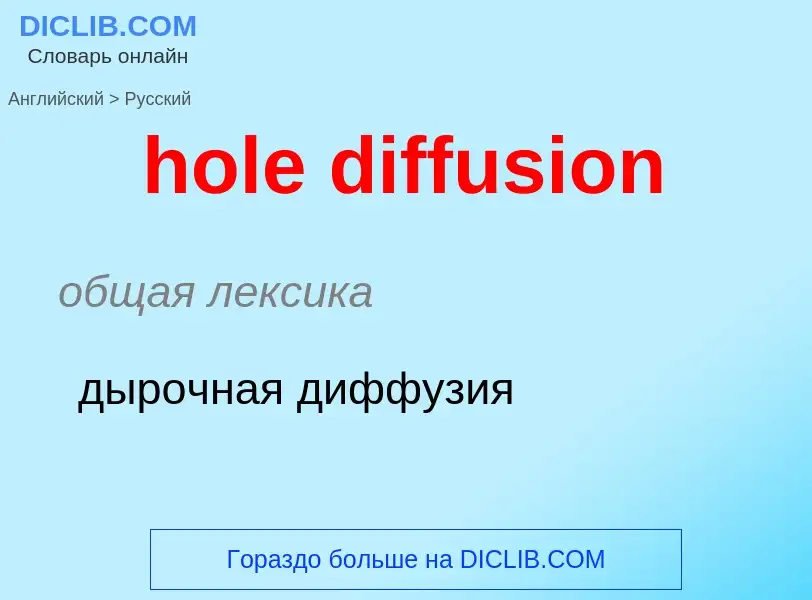Перевод и анализ слов искусственным интеллектом ChatGPT
На этой странице Вы можете получить подробный анализ слова или словосочетания, произведенный с помощью лучшей на сегодняшний день технологии искусственного интеллекта:
- как употребляется слово
- частота употребления
- используется оно чаще в устной или письменной речи
- варианты перевода слова
- примеры употребления (несколько фраз с переводом)
- этимология
hole diffusion - перевод на русский
общая лексика
дырочная диффузия
общая лексика
диффузионная сварка
общая лексика
дырочная электропроводность
дырочная проводимость
общая лексика
перфорировать отверстие
общая лексика
пробивать отверстие
[həul|inðə'wɔ:l]
прилагательное
разговорное выражение
жалкий
захудалый
существительное
[həulinðə'wɔ:l]
общая лексика
лавчонка
магазинчик
разговорное выражение
шинок
подпольная винная лавка
2) растрачивать, расходовать
[di'fju:ʒ(ə)n]
общая лексика
диффузия
размывание
расплывание
рассеяние
медицина
диффузионный (относящийся к диффузии)
Смотрите также
существительное
общая лексика
распространение
многословие
расплывчатость
физика
рассеивание
диффузия
рассеивание, диффузия
Определение
)
Википедия
The diffusion of plasma across a magnetic field was conjectured to follow the Bohm diffusion scaling as indicated from the early plasma experiments of very lossy machines. This predicted that the rate of diffusion was linear with temperature and inversely linear with the strength of the confining magnetic field.
The rate predicted by Bohm diffusion is much higher than the rate predicted by classical diffusion, which develops from a random walk within the plasma. The classical model scaled inversely with the square of the magnetic field. If the classical model is correct, small increases in the field lead to much longer confinement times. If the Bohm model is correct, magnetically confined fusion would not be practical.
Early fusion energy machines appeared to behave according to Bohm's model, and by the 1960s there was a significant stagnation within the field. The introduction of the tokamak in 1968 was the first evidence that the Bohm model did not hold for all machines. Bohm predicts rates that are too fast for these machines, and classical too slow; studying these machines has led to the neoclassical diffusion concept.


![Animation of sheet forming process using diffusion welding (see also [[hydroforming]]). Animation of sheet forming process using diffusion welding (see also [[hydroforming]]).](https://commons.wikimedia.org/wiki/Special:FilePath/Output 9GbY2F.gif?width=200)









![Binder]]-based and discbound [[loose leaf]] systems Binder]]-based and discbound [[loose leaf]] systems](https://commons.wikimedia.org/wiki/Special:FilePath/Binder-based and discbound loose leaf systems.jpg?width=200)



![chad]] collector chad]] collector](https://commons.wikimedia.org/wiki/Special:FilePath/Hole punch.jpg?width=200)

.jpg?width=200)


![Diffusion furnaces used for [[thermal oxidation]] Diffusion furnaces used for [[thermal oxidation]]](https://commons.wikimedia.org/wiki/Special:FilePath/Centrotherm diffusion furnaces at LAAS 0481.jpg?width=200)

![Diffusion from a microscopic and b macroscopic point of view. Initially, there are [[solute]] molecules on the left side of a barrier (purple line) and none on the right. The barrier is removed, and the solute diffuses to fill the whole container. <u>Top:</u> A single molecule moves around randomly. <u>Middle:</u> With more molecules, there is a statistical trend that the solute fills the container more and more uniformly. <u>Bottom:</u> With an enormous number of solute molecules, all randomness is gone: The solute appears to move smoothly and deterministically from high-concentration areas to low-concentration areas. There is no microscopic [[force]] pushing molecules rightward, but there ''appears'' to be one in the bottom panel. This apparent force is called an ''[[entropic force]]''. Diffusion from a microscopic and b macroscopic point of view. Initially, there are [[solute]] molecules on the left side of a barrier (purple line) and none on the right. The barrier is removed, and the solute diffuses to fill the whole container. <u>Top:</u> A single molecule moves around randomly. <u>Middle:</u> With more molecules, there is a statistical trend that the solute fills the container more and more uniformly. <u>Bottom:</u> With an enormous number of solute molecules, all randomness is gone: The solute appears to move smoothly and deterministically from high-concentration areas to low-concentration areas. There is no microscopic [[force]] pushing molecules rightward, but there ''appears'' to be one in the bottom panel. This apparent force is called an ''[[entropic force]]''.](https://commons.wikimedia.org/wiki/Special:FilePath/DiffusionMicroMacro.gif?width=200)

